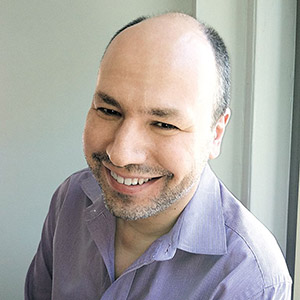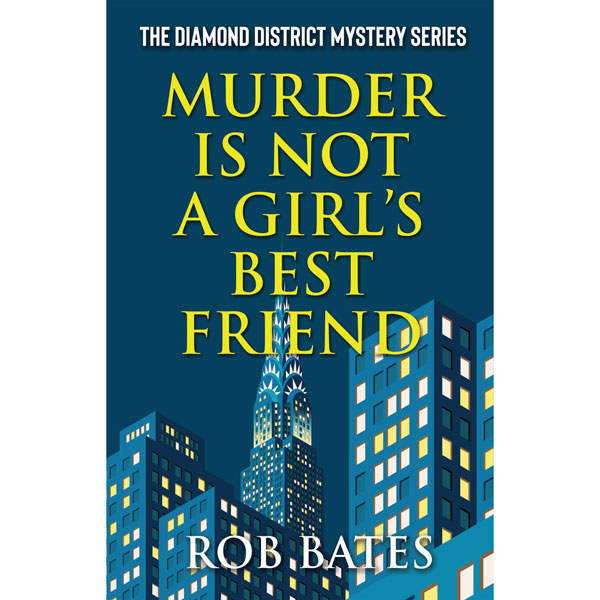
If you’re a frequent reader of JCK, you might know Rob Bates (pictured). If you’re not a frequent reader of JCK, well, you might know Rob Bates.
A true reporter in our industry, Bates has been covering the diamond industry for 30 years. Currently the news director here at JCK, my esteemed colleague is best known for diving into coverage many either don’t fully understand or don’t dare go, and he manages to make the coverage as informational as he does entertaining (the latter, perhaps, owed to his experience writing and performing comedy).
In October 2020, Bates came out with his first book, A Murder Is Forever, the first in a series of murder mysteries, which is the best and most entertaining genre, if you’re asking. And now comes the follow-up to this well-reviewed debut, the second in the Diamond District Mystery series—Murder Is Not A Girl’s Best Friend.

The sequel welcomes back protagonist Mimi Rosen, a journalist–turned–sleuth, and her father, Max, and is set in the Diamond District of New York City. The book’s synopsis is as follows:
A reverend from Africa has found a sparkling $20 million diamond that he hopes will free his continent from the scourge of blood diamonds. But this attempt to do good soon turns very bad. After the diamond is stolen and leads to a series of murders, Mimi discovers that both the diamond and the reverend have a less-than-sparkling history.
Soon, Mimi is investigating a web of secrets involving Africa’s diamond fields, a shady billionaire, offshore companies, as well as a human rights activist, documentary filmmaker, and computer whiz who may not be as noble as they appear. Is the prized gem actually a blood diamond?
Below, a few questions for our own Rob Bates, author.
You spend a great deal of time at JCK covering the diamond industry inside and out—both good and bad. Was there a particular story, or tipping point, that really sparked the idea for you to write these novels?
I have always tried to have some creative outlet outside of my work, more than just occasionally writing funny JCK headlines. I’ve done different kinds of writing, and did stand-up for a bit, and was in a weekly comedy sketch show for a few years (this was in about 2004–2005; I tended to play the bald characters like Dr. Phil and Dick Cheney).
A while ago, JCK had an employee, Jonathan Harrington, who wrote mystery books on the side. Before he left, he wrote a diamond-themed story that included me as a character, which I provided some input for. That put the notion in my head, because I thought that a mystery series set in the Diamond District would be commercial.
A while later, a friend of mine, Tripp Whetsell, introduced me to his editor, and the editor agreed the idea had potential, though he told me to make the main character female, as that’s the target audience for mysteries. That turned out to be a good idea, even without the target-audience thing.
Did you already have plans for the story line of book two when you wrote your first book?
I didn’t want to tackle social issues in the first book, since I felt they were a little overdone, but I knew I had to deal with them eventually, so I figured I’d get it over with. But more than the subject matter, early on, I chose the title. I’m very pleased with the title.
I read somewhere that the second in a series is sometimes darker and more serious, so I guess that’s true there. Though, really, the point was to write a fun book. This book deals with serious topics, but it has a lot of comedic moments, and most of all, I hope people enjoy it.
The book is packed with details only someone who works in or close to the diamond industry would have knowledge of. How important was it to you to take readers into that world? What information do you want the average consumer to come away with, if anything, about the diamond industry?
If I had a message, it’s that, like any business, the diamond business includes a wide range of people. You see films like Uncut Gems and they paint a very negative portrait of the industry. I know those bad aspects exist, and my book doesn’t gloss over them, but that’s not all there is to this industry, and I wanted to show that. Some of the nicest, warmest, most honorable people I have ever met are in this business. (I should add that my grandfather was a diamond dealer, and the other main character was named after him; he was a good guy too.)
This latest book concludes with an afterword, which includes some quick thoughts on responsible sourcing, as far as what people should look for when they buy jewelry, and I hope that will be a useful resource.
I’m pretty sure most of the people who bought the first book were from the trade. But in May, a Harlequin edition of the first book is coming out, for their mystery line, so that should expand its reach.
Who, if anyone, inspired Mimi Rosen? Are any other characters in the book inspired by people in your life?
The main character’s name was my late mother’s, but I named her that more as a tribute more than a reflection of my mom. I guess the main character was inspired by many people. My wife, Susan Posnock, worked for a newspaper, so I used some aspects of her experience. (She’s also an awesome feedback giver.)
There’s a lot of me in the main character, as there’s a lot of me in all the characters. When I first showed my drafts to friends, some thought the main character was a little too obnoxious and awkward, so I toned that aspect down. But that must have been my influence.
You’re the news director at JCK—where you also conduct a podcast—a father, a comedian. How did you find time to write a novel?
Researching some of the topics in my books has definitely informed my work at JCK, so it’s not totally separate. I’ve retired from the comedy world, not that the comedy world’s noticed. I have also mostly stopped checking Twitter and am not very active on Facebook or Instagram, so that has given me a lot of my life back. I also haven’t seen a lot of those cool Netflix shows that everyone’s binged. Someday, I’d like to. I also have several hundred podcasts I’d like to listen to.
In general, though, finding time is difficult, and I am an easily distracted person, but I guess in a way it’s lucky that COVID canceled everything, as I didn’t have to worry about a social life or anything.
Do you have a favorite murder mystery book or series?
I never read a lot of mysteries before I started this, but now I read a lot. All the old classic writers, like Agatha Christie, are great, which is why they are old classic writers. I read the first Fletch book and that was great, and recently read Rebecca, which was amazing. Diamond people may like The Moonstone, which has a diamond-themed plot, and is a pretty funny book considering it’s over 150 years old.
I also sometimes listen to old radio, and one show, Pat Novak for Hire, starring Jack Webb, is completely over the top and hilarious. Many old-time radio mysteries are good, but that’s a long topic for another day. (Also my eight-year-old has become a big Hitchcock fan, which is kind of awesome.)
Also, let me plug JCK alums Daniel Ford and Richard Dalglish, both of whom have put out novels, as well as some other fine folks who write about the industry: Richard Wise, Matthew Hart, and Neil Behrmann. I enjoy meeting other writers, because we get a chance to whine together.
Do you have any plans for a third in the series?
Yes, and I’m stressing about it even as I type this. It will be on a cursed diamond. I have my plot mostly worked out, though, unlike last time, I’m still working on a title. Folks out there are welcome to provide me with a great title.
Murder Is Not A Girl’s Best Friend is available now on Amazon, IndieBound.org, and Barnes and Noble.
- Subscribe to the JCK News Daily
- Subscribe to the JCK Special Report
- Follow JCK on Instagram: @jckmagazine
- Follow JCK on X: @jckmagazine
- Follow JCK on Facebook: @jckmagazine






